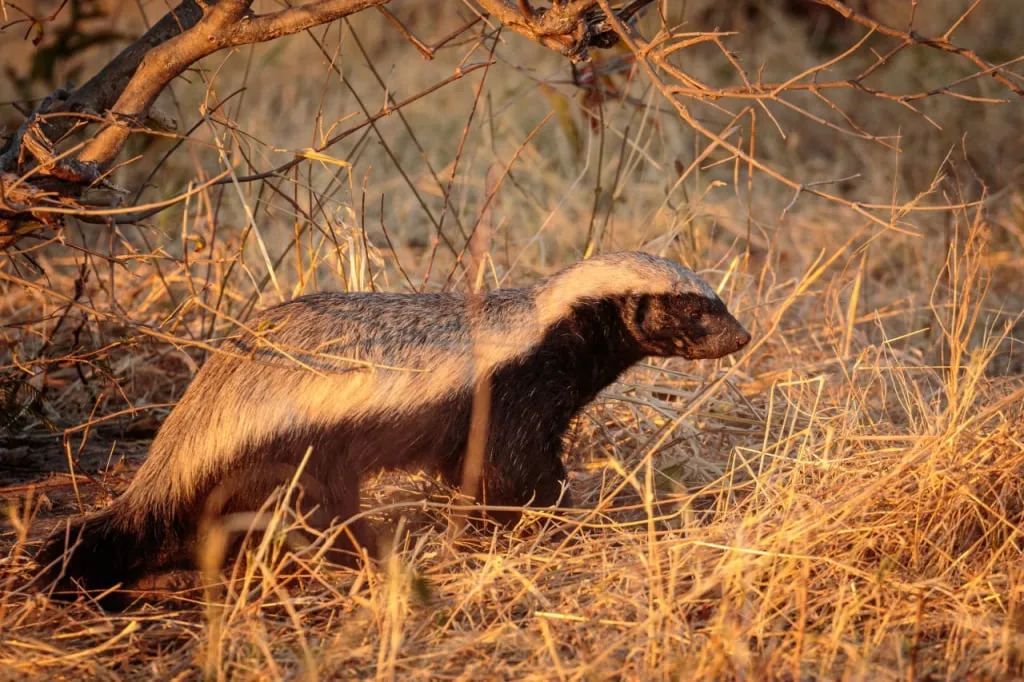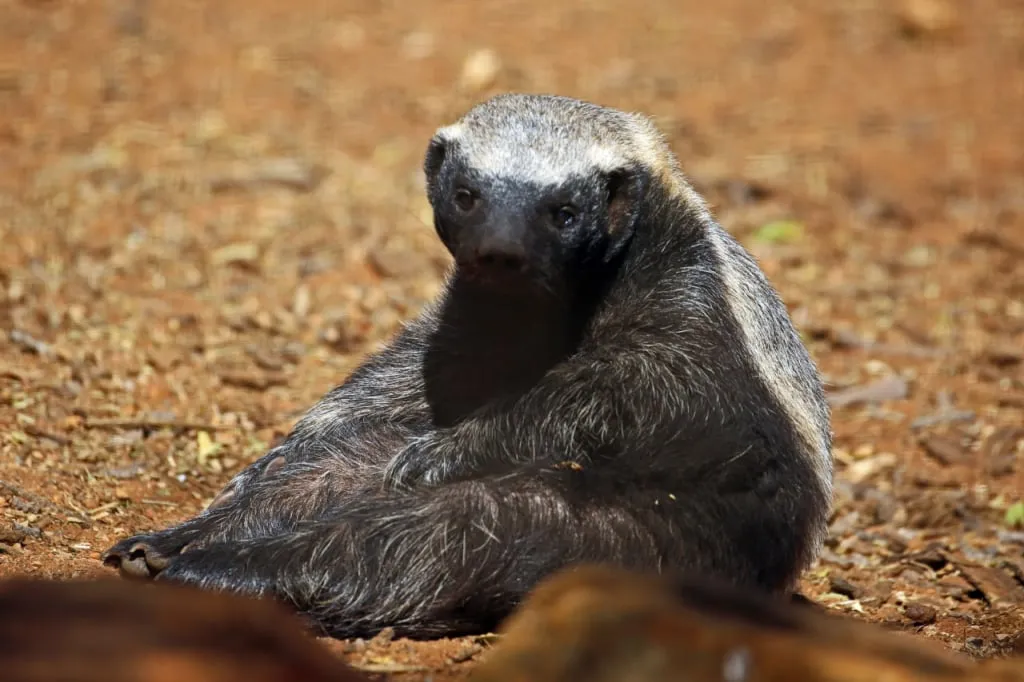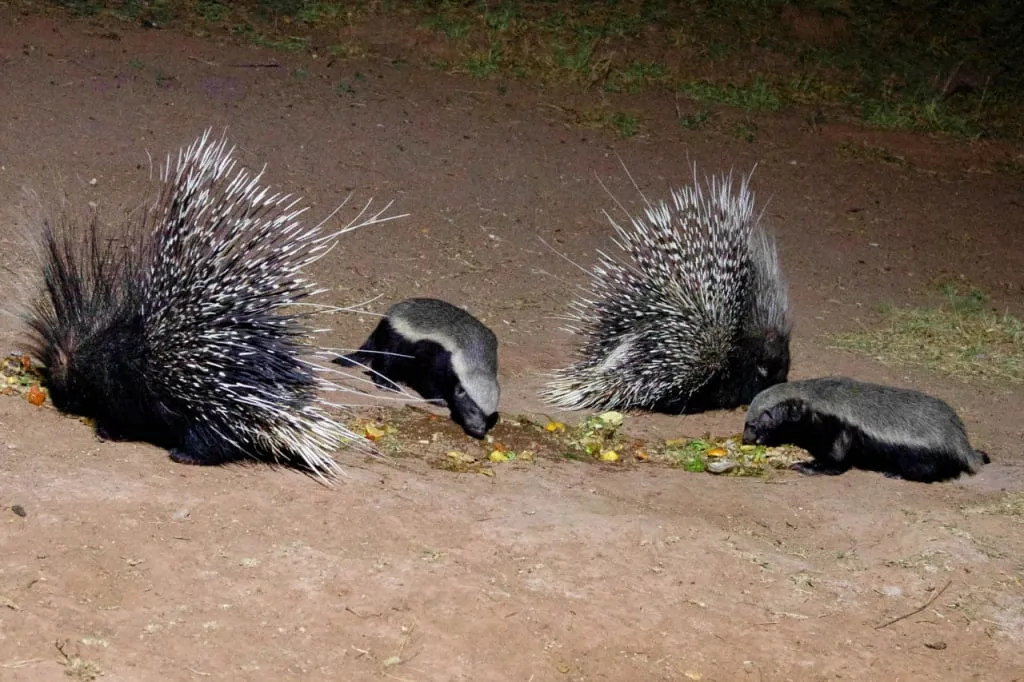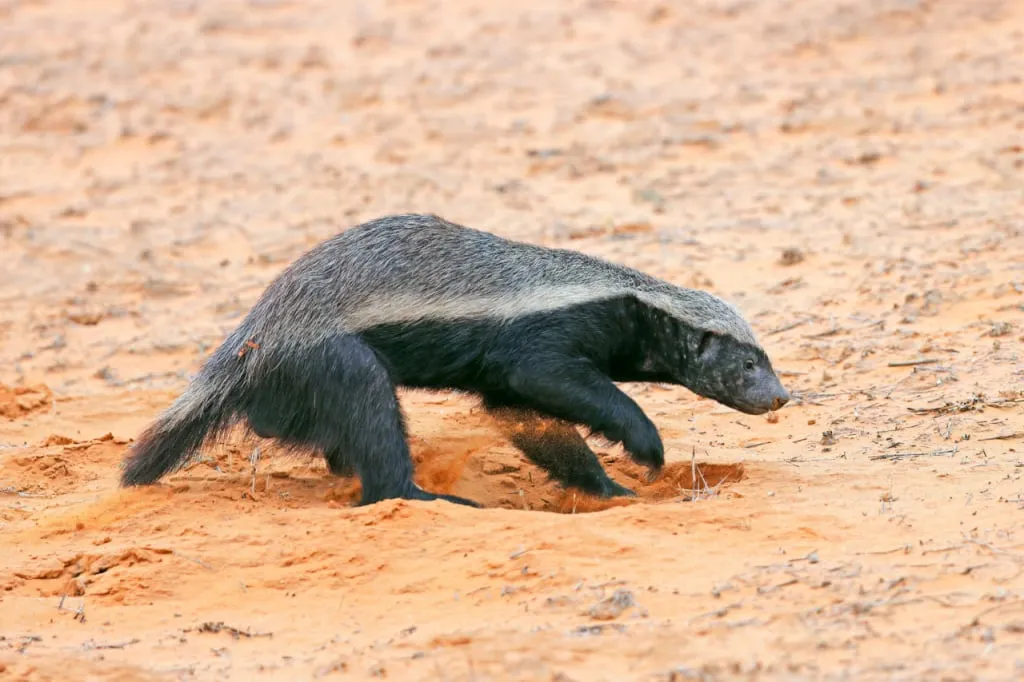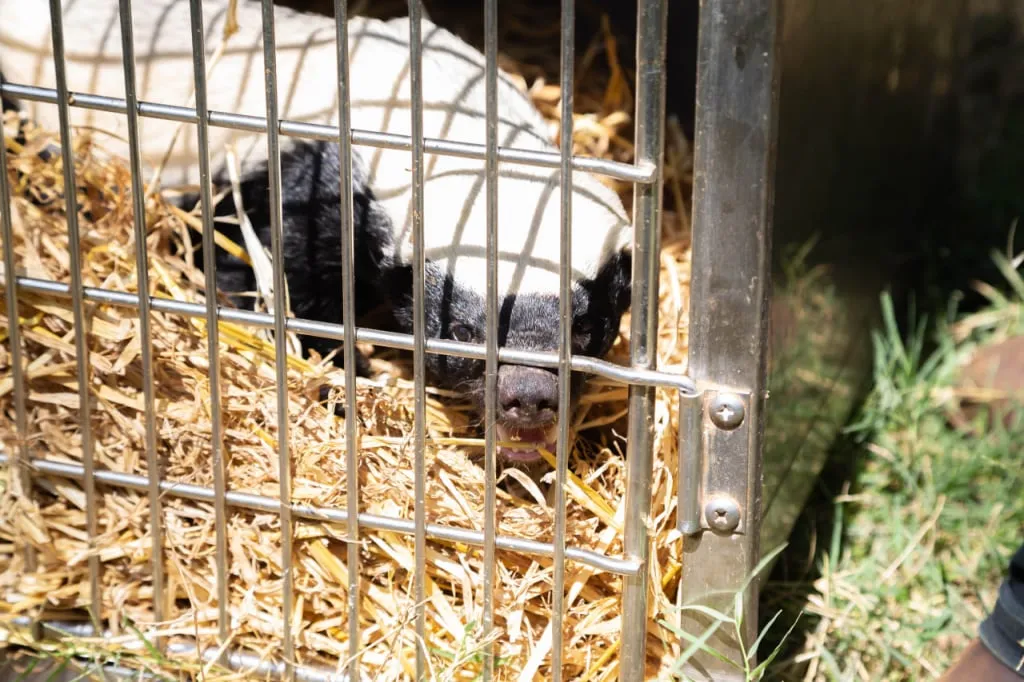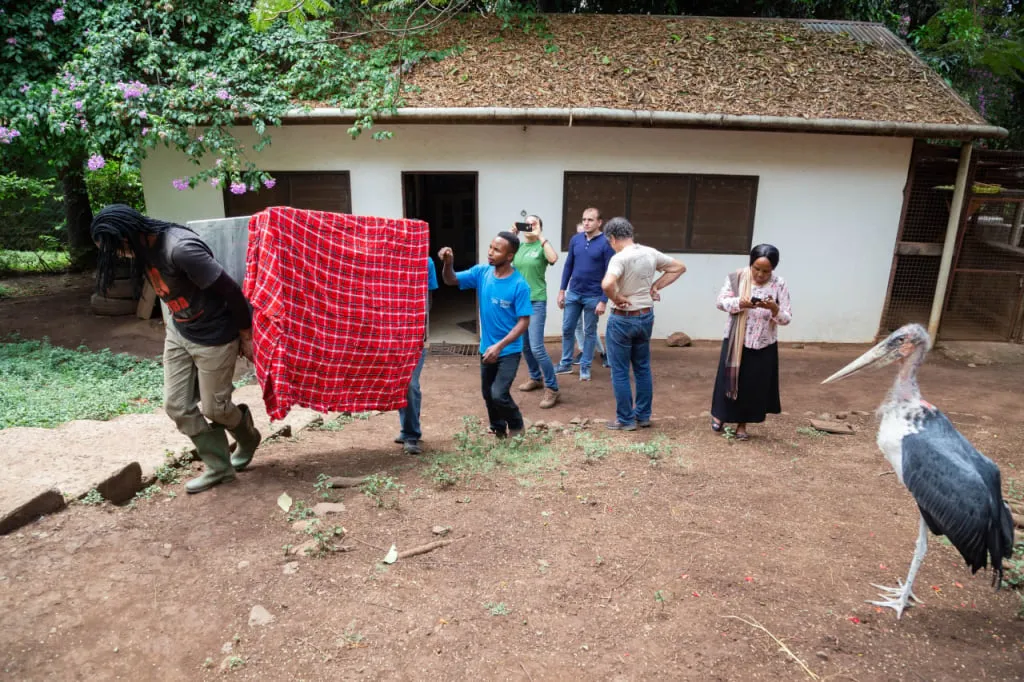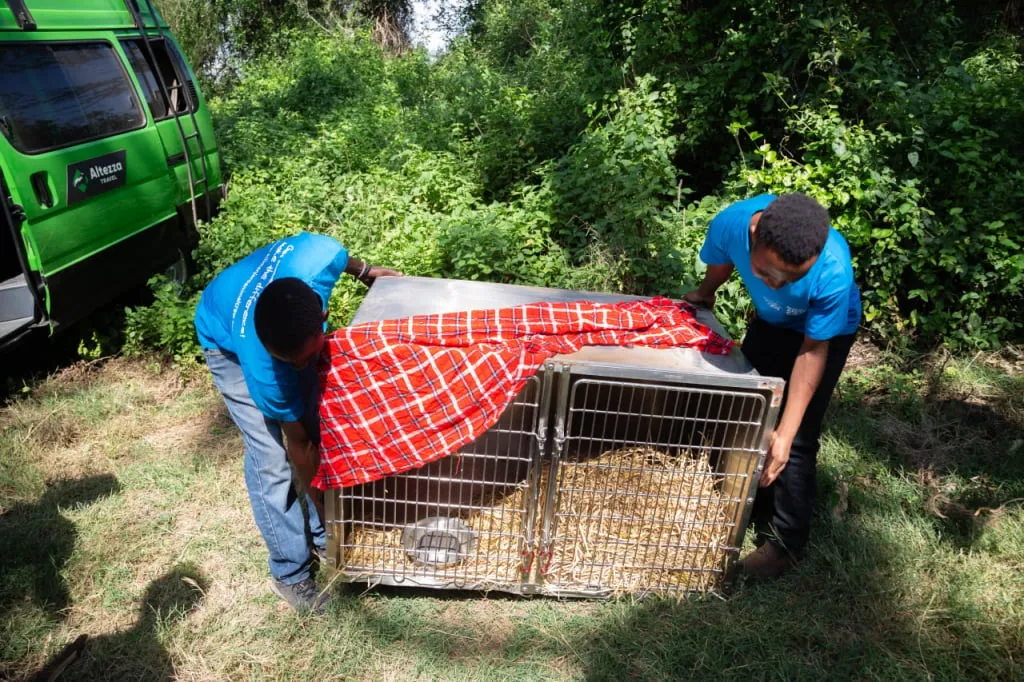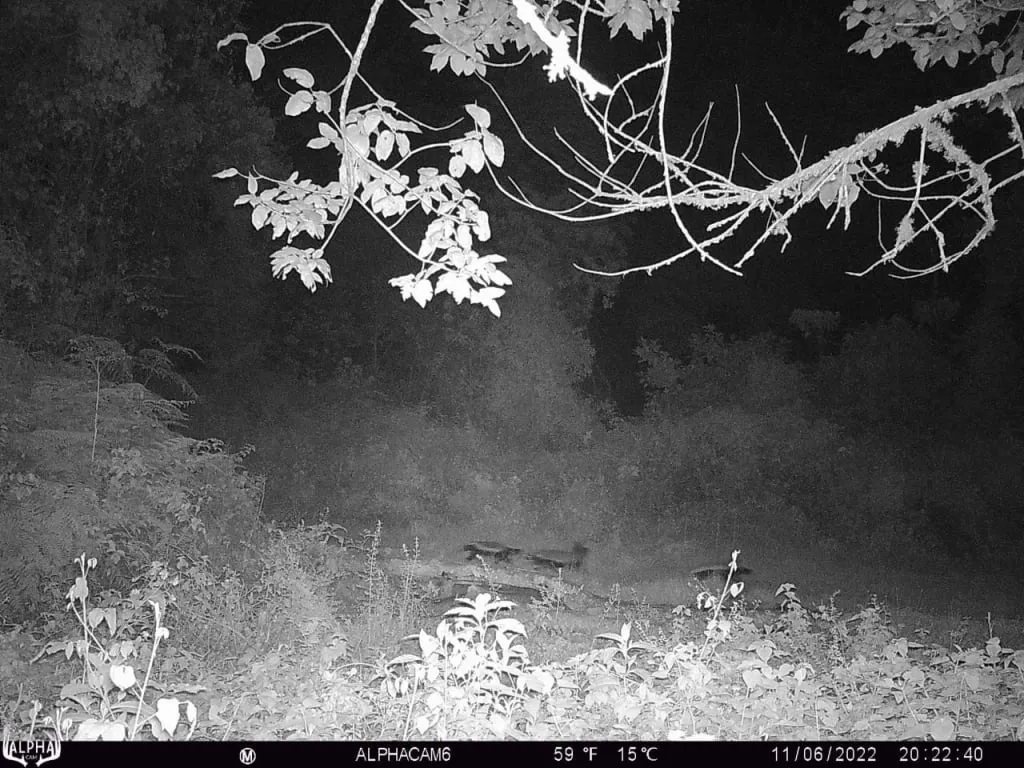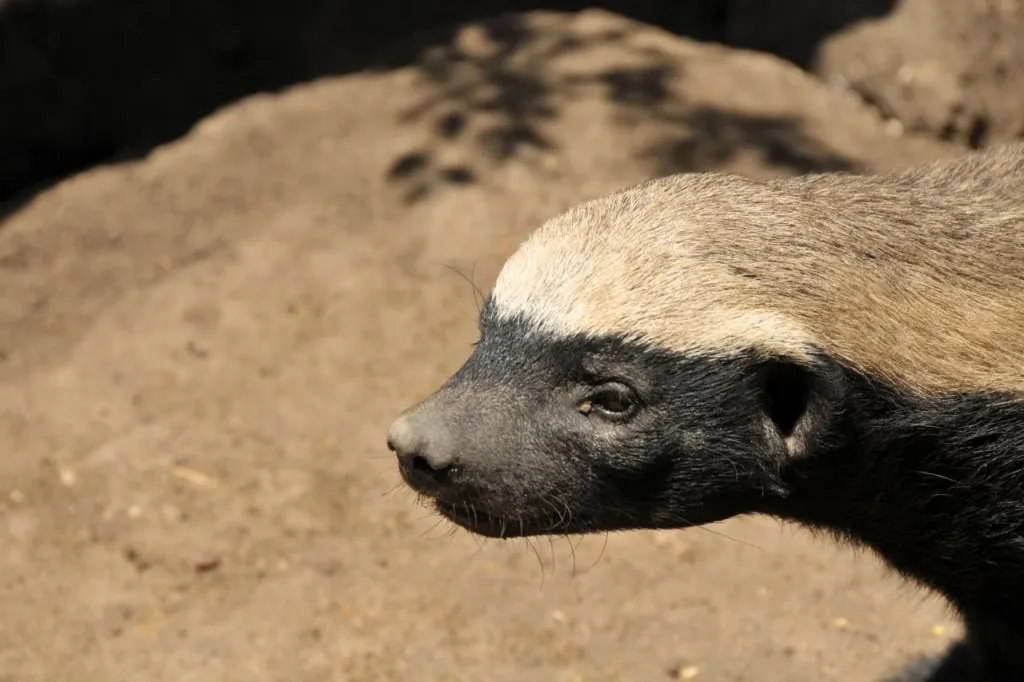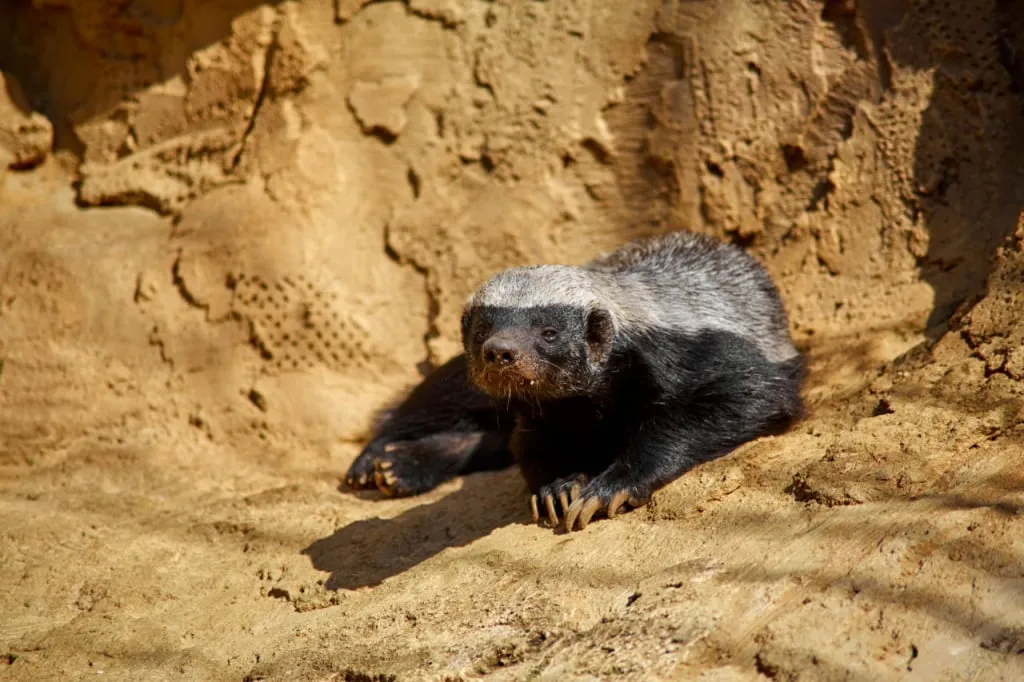We'll tell you everything we know about the honey badger, also known as the ratel. Are they truly as fearless as they are said to be? We'll show you the most famous videos of honey badgers and share the story of our encounter with these animals. We'll also explain why, at Altezza Travel, we chose to depict the honey badger in our logo.
As seen in the photo, honey badgers somewhat resemble colobus monkeys - beautiful African primates. The front part of their bodies is black, while the back is white. Colobus monkeys are among the animals we've written about while living near them. We've introduced readers to other inhabitants of African trees - tree hyraxes, small antelopes collectively called duikers, and the darlings of our hotels' guests - cute big-eyed bushbabies. We also have an article about the graceful serval cats. Welcome to the world of African animals!
Who is the honey badger?
- Despite being called a honey badger, it eats far more than just honey. The ratel is an omnivorous and incredibly voracious animal.
- It made it into the Guinness World Records as the most fearless animal.
- Honey badgers have been observed attacking lions and buffaloes.
- They are not afraid of scorpion stings and bites from venomous snakes.
- Despite their short legs, they can run dozens of miles in a single day.
- If you look at our website's logo right now, you'll see a small animal on a green/yellow diamond. That's the honey badger, the mascot of Altezza Travel.


The honey badger is a terrestrial animal with short legs that inhabits forests, steppes, and mountains in Africa and Asia. You might have heard another name for the same animal - ratel. It's rarely seen, but when it happens, you can recognize it by the white-gray woolly coat on its head, back, and tail, contrasting with the black color of its face, sides, and lower body. Fully black honey badgers also exist but are limited to one subspecies.
This omnivorous animal's favorite treat is bee larvae, for which it digs through beehives. People noticed this behavior, earning it the nickname "honey badger". Although it also eats honey, its main treat, is the larvae and pupae of bees.
Where do honey badgers live? They are found almost throughout sub-Saharan Africa, as well as in Mali, Mauritania, Western Sahara, and Morocco. The Asian habitat includes parts of Western Asia (Middle East) and the Indian Peninsula. As of today, about 12 subspecies are recognized. These include Persian ratel, Nepalese ratel, Indian ratel, black ratel, white-backed ratel, Lake Chad ratel speckled ratel, among others.
The badger's most famous characteristic is its fearlessness, even in the face of much larger opponents. When a massive animal, such as a buffalo, invades the honey badger's territory, this member of the weasel family launches an attack. A cornered honey badger is extremely dangerous. It will fiercely defend itself and its territory, raising fur, showing its sharp teeth and long claws, hissing and growling, and emitting a foul odor. If the opponent doesn't retreat, rest assured - the honey badger will fiercely engage in battle.
Why are honey badgers so strong, fearless and aggressive?
Legends surround the extreme fearlessness of honey badgers. Wildlife documentary enthusiasts know that honey badgers hunt venomous snakes, fearlessly confront larger opponents, and sometimes even attack lions, buffaloes, and horses. Often, they emerge victorious from these battles.
How is this possible? One of the secrets lies in the honey badgers' very thick skin. It is challenging to bite through with teeth or pierce with, for example, porcupine quills. Describing their skin, some use the term "loose" emphasizing its elasticity and stretchability. This allows a captured honey badger to twist, turn, and continue attacking its assailant. Despite its pliability, the skin is quite dense – locals say that neither arrows nor machete blades penetrate it.
For attacks, honey badgers have short but powerful paws with long, curved claws. Nature bestowed these claws upon them for digging burrows, destroying termite mounds, and beehives. However, the fearlessness of honey badgers allows them to employ their claws in battle. The powerful paws not only help them fend off attackers but also pursue prey for an extended period until it succumbs, thoroughly exhausted. So, their ability to drop a "stink bomb" is not their only weapon!
But what about snake venom? It appears that honey badgers have an antidote in their system. It is known that honey badgers hunt venomous cobras, for example. If a cobra bites the honey badger before dying, the venom may induce a kind of lethargy. However, about two hours later, the animal wakes up, fully reenergized, and calmly finishes consuming the slain cobra. And that is if the snake fangs manage to catch the badger and penetrate its skin.
There are speculations about how this might work. Honey badgers are not the only animals capable of neutralizing snake venom. This ability is also present in opossums, hedgehogs, skunks, mongooses, and some other animals. For instance, mongooses have a different protein composition in their muscle and nerve cells, preventing toxin molecules from binding and causing paralysis. Other animals have substances in their blood that neutralize venom toxins. The specific physiological mechanism of protection against venom in honey badgers remains unknown.
Another defense mechanism is the ability to release a liquid with a strong unpleasant odor in dangerous situations. Enlarged anal glands are responsible for this. The foul smell can deter not only insects like bees but also larger animals that honey badgers might encounter. In this aspect, they resemble skunks.
Finally, let's talk about bee stings. How do honey badgers avoid the consequences when infiltrating a beehive? In most cases, honey badgers don't feel the stings and are unaffected by them, thanks to their thick skin. There is a widespread belief that bees don't harm them at all. However, there are rare instances of honey badgers trapped in beehives, enduring prolonged attacks, and eventually succumbing to numerous stings.
Nevertheless, more often than not, honey badgers remain alive and nearly unharmed. Their character, marked by bravery and active defense quickly turning into aggression, plays a crucial role. In this aspect, honey badgers resemble their family relative, the wolverine, which inhabits northern latitudes. While the honey badger has been spotted attacking lions and buffaloes, wolverines sometimes engage bears in a similar manner.
Viral video: Honey badger don't care
You might have come across this legendary video of the wild honey badger on the internet. Watch it again with the knowledge of what makes this animal so fearless. (warning: strong language!)
Uploaded on YouTube in 2011, this video became extremely popular, garnering over 100 million views. The original footage was shot for the National Geographic Wild channel. Randall, impressed by the honey badger's behavior, decided to overdub the footage, adding some fun. The video quickly went viral, turning into an internet meme. More people learned about honey badgers than ever before.
Viewers appreciated Randall's style, leading to the release of a book on animals with his commentary and several commercials featuring his voice.
This video gave rise to a new slang meaning of the word "honey badger" in English. People began using "honey badger" to describe individuals who don't care about others' opinions, who don't worry about what others think, and simply do what they want.
Diet. Honey badgers and what do they eat?
Honey badgers are called opportunistic scavengers, adapting to external circumstances. This is another trait that links them to wolverines, which also have a broad diet.
Perhaps it's easier to list who or what the honey badgers don't eat. Nevertheless, we'll try to describe their dietary habits and prey species. Their diet is based on the season and the abundance of small animals at the moment. Honey badgers are mostly carnivorous, capturing and consuming small rodents, snakes, frogs, and birds. They enjoy indulging in bird eggs, for which they can easily climb a tree. Almost any animal weighing up to two kilograms, sometimes more, can end up in a honey badger's stomach. Over 60 species of honey badgers' prey were recorded in the southern Kalahari desert alone! Notable examples of large prey include African wildcats, Cape foxes, bat-eared foxes, and scrub hares. Moreover, honey badgers effortlessly crack open the shells of turtles, reaching the tender meat within.
Among snakes that fall prey to the honey badger, we can list puff adders, horned adders, Cape cobras, mole snakes, black mambas, and even Southern African rock pythons. Many of the snakes they consume are extremely venomous. Scorpions, whose venom also doesn't harm honey badgers, can be added to this list.
Watch how honey badgers face other animals in this video. It features 17 confrontations between honey badgers and various representatives of the animal kingdom.
It is worth mentioning separately that honey badgers sometimes become unpleasant neighbors for humans, raiding chicken coops and killing a large number of domestic birds. Thanks to their long claws and digging abilities, honey badgers create burrows, and with their strong paws, they easily dismantle thick boards, disassembling chicken coops. Protecting against them is not that simple.
Interestingly, after capturing prey, honey badgers consume it entirely, not refusing skin, feathers, fur, or bones. By the way, honey badgers also do not shy away from scavenging. Among other things, British zoologist Reginald Innes Pocock mentioned in his book reports from India that they dug up human remains.
Smaller members of the animal kingdom that become food for honey badgers include various insects, including the mentioned bee larvae for which they infiltrate beehives.
Moreover, honey badgers consume plants: roots, bulbs, berries, and fruits. This fact makes them omnivorous. It is reported that sometimes they eat fruits not for sustenance but for the liquid. This happens more often in arid regions.
Their favorite activity is to break into beehives, termite mounds, and burrows of different rodents. They enter burrows, use their hind legs to seal the exit, and with their powerful front legs, widen the passage, reaching their prey. Honey badgers have an excellent sense of smell, so hiding from them in a burrow is futile.
Who poses a threat to honey badgers?
It is believed that honey badgers have almost no natural enemies, as many large predators, knowing their character, avoid dealing with them. However, there are cases where lions and leopards have killed honey badgers. The victims were typically old or weakened individuals. In most cases, a healthy honey badger can drive away predators. For example, there is a documented case where a honey badger engaged in battle with 6 lions and managed to escape relatively unharmed!
However, in some instances, predators of honey badgers can include hyenas, leopards, lions, and Nile crocodiles. Generally speaking about threats, the only constant problem for them is humans. People hunt honey badgers for meat and use parts of these robust animals for traditional medicine. The local population believes that the strength and bravery of this animal are transferred if a part of the honey badger's body is obtained.
Another problem is beekeepers setting traps for honey badgers to protect beehives. Sometimes, humans poison them to prevent them from approaching beehives and chicken coops.
All in all, this does not pose a significant threat to the species. According to the International Union for Conservation of Nature (IUCN), although the overall honey badger population is decreasing, the species is not seriously threatened. Its conservation status is of Least Concern. The secluded lifestyle and the remoteness of honey badgers' habitats from humans primarily contribute to their survival. However, conservation biology classifies them as endangered in some particular habitats.
Natural habitat and behavior: Where and how do honey badgers live?
Honey badgers thrive in various climatic zones: steppes, savannas, rocky areas, open coastal territories, forests, and mountains. Reports suggest sightings at altitudes up to 4000 meters above sea level. The only places they are not found are lowland tropical forests.
As this animal is quite voracious, it spends most of its time searching for food. Honey badgers usually live alone. In doing so, they mark their territory for other males, creating huge home ranges, sometimes reaching 500 sq kilometers (193 sq miles). In one day, a male honey badger can cover up to 27 kilometers (17 miles) to find food.
Although they are solitary animals, sometimes they can be seen in pairs. During the mating season, honey badgers may hunt together, a male and a female. It's a very rare sight to see honey badgers mate. The expectant honey badger diligently digs a nursery chamber, lining it with soft grass for her soon-to-arrive cub. After a gestation period of 7 to 10 weeks, a single (rarely two) hairless cub emerges, born blind and helpless with delicate pink skin.
Occasionally, males form bachelor groups. And sometimes, a female mother honey badger with cubs can be observed. However, in most cases, honey badgers hunt alone. Seeing a group of several individuals is a rare occurrence.
Honey badgers often go hunting at night, but they can also be encountered during the daytime. The key is not to miss the encounter. Some of us from the Altezza Travel team experienced exactly that. We were on safari in the Mkomazi National Park. After a long day exploring the vastness of the park, the most tired among us wanted to rest in the car, closing our eyes for five minutes. It was a mistake. Right at that moment, a honey badger crossed the road. "Honey badger!" the driver joyfully shouted. But it was too late; the animal instantly disappeared into dense vegetation. Those who closed their eyes missed the rare opportunity to see this remarkable creature. It is something they regret to this day.
Since a large home range requires constant patrolling, the honey badger has several burrows for resting. Thus, they rarely spend two consecutive nights in the same burrow.
Honey badger homes
Typical honey badger habitat consists of a burrow that it digs using its long claws on the front paws. It is like a tunnel that can be up to three meters (9.8 feet) long. Moreover, the animal can dig up to one and a half meters (4.9 feet) deep. It takes about 10 minutes for it to dig a tunnel in solid ground.
Often, honey badgers simply take over other animals' homes, breaking into ready-made burrows of aardvarks, foxes, mongooses, and warthogs. Sometimes they use vacant termite mounds.
It is not a problem for them to spend the night in rocky terrain. In this case, honey badgers arrange their den in rock crevices. Tree hollows also serve as suitable sleeping spots. Overall, honey badgers are versatile animals when it comes to housing arrangements, just like their diet.
We even know of a honey badger that settled on the logo of an African safari company :)
Honey badger on the logo of Altezza Travel
Let us tell you a little about ourselves so that you understand how we are connected to the animals of Africa. We are Altezza Travel, a company from Tanzania, a country in East Africa. Tanzania is famous for its amazing wildlife, with vast national parks where wild animals live freely.
We organize safari tours to Serengeti, Ngorongoro, Tarangire, and other national parks and reserves. It is our passion to help travelers witness all the splendor of African nature with their own eyes. We also organize expeditions to Mount Kilimanjaro, the highest mountain in Africa. Both Kilimanjaro and the legendary national parks are located here in Tanzania.
When we were coming up with the company logo, we wanted to see an interesting African animal on it. We didn't want to use animals like lions, zebras, and giraffes, whose images are used in one logo after another. We needed something more interesting. We tried drawing a porcupine and other animals, but the honey badger looked the best. This creature personifies the animal world of Tanzania and is a reference to safari. On the other hand, its unique black and white coat resembles the snow-capped peak of Kilimanjaro and refers to mountain expeditions. Bingo! We found the perfect animal mascot for Altezza Travel.
It seems that with the image of the honey badger on our logo, we once attracted a real animal. Let us tell you about our meeting with it.
How Altezza Travel rescued a honey badger
We have an interesting story about how we once had to rescue a honey badger from the hands of farmers and release it into the wild. We already knew that we had to be on our guard with honey badgers, and we prepared for the rescue operation with all due care.
The incident happened in 2018. Our office is located on the territory of our own hotel Aishi Machame Hotel, which is surrounded by lush forests at the foot of Kilimanjaro. There is a large village of Machame nearby. Many locals are working in farming and small livestock breeding.
One evening, local farmers brought a honey badger to our office in a pickup truck. The animal had been caught in the village and tied up with ropes. The animal had climbed into a chicken coop, where it was caught. The farmers offered to sell us the tied predator. It is illegal to trade in wild animals in Tanzania. Of course, we refused and called the Ministry of Natural Resources and Tourism. The Tanzania Wildlife Research Institute (TAWIRI), which is under the management of the ministry, deals with all issues related to wild animals that have ended up in the hands of people.
The farmers left the honey badger with us simply because they did not want to deal with a state organization, as they could be fined. So suddenly we had a wild and dangerous animal in our care. TAWIRI promised to send us rangers the next day to help us transport the honey badger to the wild and release it.
Not far from Machame, there are commercial sugar cane plantations (TPC). The company that produces sugar has a reserve where antelopes, zebras, porcupines, and other animals live in their natural environment. We agreed with the management of TPC that we would release the honey badger in their reserve.
The next day, the Altezza Travel team set off for the reserve together with TAWIRI rangers under the supervision of a veterinarian who specializes in helping injured wild animals. The honey badger was riding with us in a secure cage. But even this fact did not reassure our colleagues, who had to travel with the animal in the same car. Everyone had heard about the aggression and fearlessness of honey badgers, so no one wanted to approach the cage.
In the forest zone of the reserve, two minivans carrying a honey badger rescue operation team stopped at a trail. All participants of the operation took up safe positions away from the cage with the animal. The cage was lowered to the ground and the door was opened with all precautions using sticks and ropes. No one dared to approach the cage with the honey badger. The manipulations were performed from the roofs of the buses, where everyone climbed.
Finally, the honey badger carefully got out of the cage and ran away into the forest quite quickly. The members of the rescue group breathed a sigh of relief. The honey badger did not attack or tear anyone apart. Jokes aside, everyone was really nervous. The operation to rescue the mascot animal of Altezza Travel was successful. The honey badger was free.
Honey badger on a camera trap in the Kilimanjaro forest
In 2022, taking advantage of our proximity to the Kilimanjaro forest, we installed several camera traps in the forest zone of the mountain to understand what animals live there today. Several forest inhabitants were caught on camera, including the rare Abbot's duiker, and several honey badgers.
The photograph shows a group of three honey badgers traveling through the forest at night. As we previously mentioned, these animals typically hunt alone. This trio seems to be a bachelor group or a family that stays together.
We were thrilled with such luck. Capturing three adult honey badgers in a single frame in the wild is quite rare. We were able to accomplish it. The Altezza Travel company, which uses the honey badger as its brand symbol, appears to be fortunate with these animals.
Where else can you meet a honey badger?
We were curious to learn who else utilizes the honey badger image to represent themselves. As expected, the image is popular in the sports world. Athletes are clearly drawn to the honey badger's fearlessness and tenacity.
In Canada, a professional basketball team called the Brampton Honey Badgers competes in the Canadian Elite Basketball League. The team not only adopted the animal's name but also features the honey badger prominently in its branding. Notably, the Brampton basketball players became champions of the elite league in 2022. The "honey badger magic" undoubtedly plays a role. Interestingly, honey badgers are not native to Canada.
Some of the most well-known athletes who have been given the nickname "Honey Badger" include Australian rugby player Nick Cummins, Australian race car driver Daniel Ricciardo, Canadian hockey player Brad Marchand, and Canadian American football player Tyrann Mathieu. Nick Cummins claimed that he was motivated by the honey badger's fierce nature and attempted to mimic its strategies in tough defense. When someone overtook him on the track, Formula 1 driver Daniel Ricciardo mimicked the aggressive animal's style. Tyrann Mathieu received this nickname both for his tenacious football game and for his early career hairstyle, which resembled the white-gray mantle on the honey badger's head and back.
An American light carbine rifle called the AAC Honey Badger, which was produced from 2011 to 2020, was named after the honey badger. It was built for close-quarters combat during military special operations.
Additionally, the name "Honey Badger" was given to an American military operation planned for Iran in the 1980s. The goal was to rescue hostages. An innovative cargo aircraft was created during the operation's planning phase, and it set several short-takeoff records during testing. This was necessary for the safe rescue of the hostages and the special forces unit. The rescue mission itself was canceled as a result of favorable political changes, and 444 American hostages were released through negotiations.
The South African Defense Forces employ an armored personnel carrier named "Honey Badger" in honor of the resilient animal. The honey badger lives in South Africa and there it received its scientific name -
How to see wild honey badgers in their natural habitat?
We suggest taking a safari to one of Tanzania's national parks if you want to see a live honey badger. We must warn you that the likelihood of encountering one during a trip through the African savannas is quite low. Yet, it exists. And you'll still get to see many other amazingly beautiful African animals!
Choose one of Altezza Travel's safari programs and immerse yourself in the unspoiled beauty of nature. Who knows, maybe you'll get lucky, and our symbol will help you encounter a real honey badger in the vast African landscape!
Popular questions about honey badgers
Finally, let's quickly answer some frequently asked questions about these amazing mammalian species!
Is a honey badger aggressive?
Yes, honey badgers are aggressive towards larger mammals and other animals, but they generally avoid humans unless threatened.
Why is the honey badger so tough?
Their loose and thick skin, strong legs, flattened body, and resistance to venom make honey badgers incredibly tough. In addition, their ability to drop a "stink bomb" can scare away many.
Why honey badgers are fearless?
Fearlessness in honey badgers comes from a combination of factors like thick skin, strong claws, and a lack of natural predators.
Is it safe to pet a honey badger?
No, petting a honey badger is never a safe option. They are wild animals with powerful claws and teeth. Having one as a pet is not a good idea either.
Do honey badgers only eat honey?
While honey is part of their diet, honey badgers are actually omnivores who eat a variety of insects, small animals, and fruits.
What other animals are related to honey badgers?
There are many small mammals related to honey badgers. For example, yellow mongooses, ferret badgers, skunks, otters, wolverines and other badgers. In addition, there are grisons native to South America, and other species from the weasel family.












